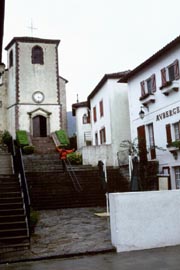In detail ...
We should really have left the train at Hendaye Plage, but the Swiss walkers persuaded us to stay on board till Hendaye Ville.
Karen_comments
That occasioned some back-tracking to facilitate ceremonial toe dipping in the muddy estuary river. Then turning our backs on the Atlantic, we marched back into town.
Hendaye: a quiet seaside town with a few shops, functional. Nothing particular to mark it as the beginning of a trans-Pyrenean route, and of course, there was no flag waving company to see us off. Here, just the Swiss knew, and a small bond of commonality was forged at the outset. They were walking the same route, but only for 14 days. At the outset they distinguished themselves as our seniors since they had walked other later sections by turn. Sensible folk who had not abandoned their jobs, making use of holiday allocation for their treks.
Knowing that the HRP keeps company with the GR10, we had left behind the French map; the ensuing Spanish map would quickly make it redundant at Col d'Ibardin of stage 1. In Hendaye however, we found no GR10 markers and Karen's failed attempt to engage the locals resigned us to a tarmac trudge. The estate road was quiet initially, leading above and parallel to the river Bidassoa which we were to meet again at Arizkun. It was only after crossing beneath the noisy
péage viaduct that we finally found a re-assuring GR10 sign.
The sky darkened and a heavy shower gave our new cags a brief test, but it was dry again as we climbed up to Biriatou village. A restaurant, a shop, and village houses all shared walls along the cobbled road till a broad stone staircase finally barred vehicles. We climbed these steps to loiter under the arches of the church which dominates all, but there was no further threat of rain, and no excuse to linger, if we only knew
where to go exactly. Something told us it should be obvious, but it wasn't, and it took quite a few minutes to locate the first GR10
balise which marked an obscure exit from the RHS of the church yard.
And so to the hills, where a steep ascent led up and away from the river, giving Karen a chance to test her new trekking poles and me, my new boots. This mountain named Choldokogagna introduced us to the ancient Euzkarien which pre-dates the indo-european languages; repeating the name was almost a greater challenge than climbing its flank, to a level well short of the 486m summit. Even so, we were grateful for the halt invited by a cool spring seeping from the crumbly red sandstone; a chance to survey the great Atlantic ocean. The darker clouds had dissipated and the afternoon was breezy and light, with sun sparkling on the now distant waves. Then, having replenished supplies, we pressed on, keen to make little of the day's humble challenge.
The British uplands are dotted with sheep, but here the foothills are populated with ponies; black, dappled, pie-bald, brown or skew-bald, select individuals wore a tinkling bell. They might well have been the
pottoks, a strain of mountain pony unique to the Pyrenees along with the
merens of Ariége. The
pottok is only found in the Basque region and comes in many shades and colours, while the
merens of Ariege is dark, almost black. They feature modest size, shaggy beards and above all, sure-footedness which makes them at home on the steepest of grassy slopes. These quiet creatures obligingly moved out of the grassy way we tramped, to relocate among the chest-high bracken. In no time at all we found ourselves overlooking a small lake, whose shores invited campers; to camp there however would have made re-ascent obligatory, so we settled for the distant view offered by Col de Poiriers.
The Eagle Owl
French: 'Grand Duc'. The French also name two other 'eared' owls as 'dukes'; the Long Eared owl and Scops owl are known respectively as 'Moyenne' and 'Petit'
ducs. Of these, only the larger two are present in the Pyrenees, along with the ubiquitous Tawny owl, the Little owl, and the rare Tengmalm's owl. Only the latter is a true mountain dweller, habituating the sub-alpine level in the east. The eagle owl is the largest with height of 60cm and wingspan approaching 1.5m (ie. 5ft); it can prey upon any creature up to the size of a roe deer! It may be seen rarely at dawn or dusk, but its grave triple note call is more often heard.
Not a pear tree in view actually, but we pitched our tent on well cropped grass in the shelter of a pine plantation. Now, the long-awaited journey really had begun, and we allowed ourselves some tentative jubilation over a celebratory dinner; tomatoes, cucumber and olives were regal fayre along with pain aux noix. The day was late now and the once white cumuli had paled to grey, still pursued on high by a stiff southerly wind, but down in the pines the breeze merely whispered. The soundscape was completed by the ponies which still munched audibly and the polyphony of owl calls; the latter caused some speculation as we retired in the gloaming. As a lad in England, the humble tawny owl used to engender a certain respect; now I am older and bigger, but here in the Pyrenees the owls too have 'grown-up' and the solemn deep warble hoo huhuhu hoo could easily be that of the majestic eagle owl!


